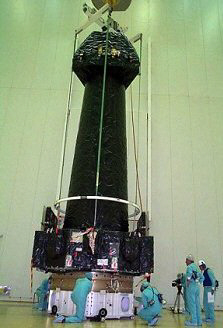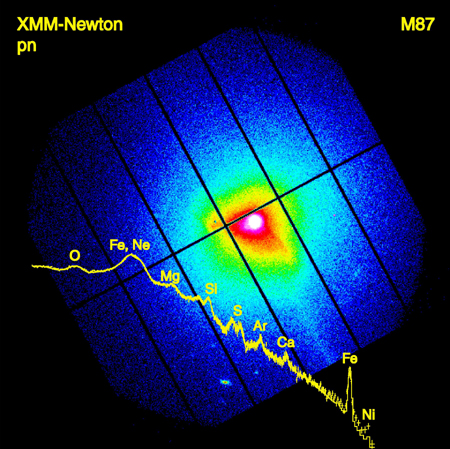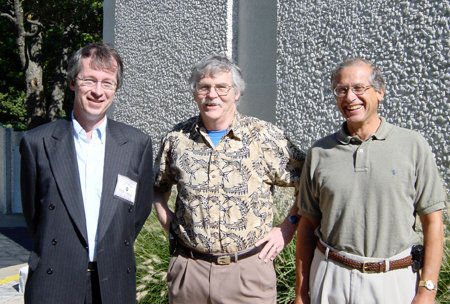Living up to expectations and looking towards the future
 |
|
XMM-Newton, seen here in Kourou in November 1999 shortly before launch, has now accumulated data on over 1200 X-ray sources, and is looking forward to a second cycle of observations. (Photo taken by D. de Chambure). |
Since its launch in December 1999, ESA's X-ray observatory XMM-Newton has observed well over a thousand sources and is already providing new insights into many of the mysteries of the Universe. Although funding has not yet formally been secured to continue beyond March 2002, the recent second Announcement of Opportunity has resulted in a record 870 proposals for new observations, indicating that ESA's X-ray observatory is even more popular second time around.
The second round of observations, to be carried out between July 2002 and July 2003, introduce the possibility of joint observations with NASA's Chandra X-ray observatory and with the European Southern Observatory (ESO) ground-based telescopes.
"As we speak, XMM is completing its 350th revolution around the Earth," says Fred Jansen, XMM-Newton project scientist. "In the first approved phase of operations, the observatory has accumulated data on ~1200 observations, and CD-ROMs have been produced for over 1000 observations. These include the guaranteed-time observations belonging to the principal investigators, the mission scientists and the survey- and telescope-scientists - and the guest observer observations resulting from the first Announcement of Opportunity. AO-2 now provides us with a second series of observations to be carried out after the initial 2.25 year period."
Question: Has the observatory lived up to expectations?
Answer: The observatory has certainly lived up to expectations. The only thing it has fallen short on is the timely delivery of data to the observers such that there is now a backlog of analysis products, which I am happy to say is now being cleared at a rapid pace. But from the data that has been analysed we know that XMM-Newton is performing extremely well. This is reflected in the scientific papers that are being published.
Q.: A few examples, perhaps, of areas of research where XMM-Newton is producing excellent results?
A.: The Reflection Gratings Spectrometer instrument, for instance, with its unique combination of resolution and 'grasp' has been showing spectral features in the brighter sources which tell us today that physical processes are quite different from what we had imagined. Quite a few theories are due for a shake-down! The same holds for the EPIC imaging cameras where we have also seen on certain targets that their properties must be very different from what we had assumed. We have also been able to take a few very deep looks back into the Universe - the most spectacular of these are yet to be made! These XMM-Newton data have been partially confirmed by Chandra, but XMM-Newton then allows us to get X-ray spectra for many of these very distant and weak sources, which is a unique feature of our observatory.
 |
|
One of many XMM-Newton images: the Virgo cluster and its giant elliptical galaxy M87 seen with the observatory's EPIC-pn camera. The X-rays come from plasma in the cluster reaching 10-30 million degrees. Overlaid on the image is an X-ray spectrum showing several emission lines of astrophysically important elements. (Courtesy Hans Boehringer, MPE). |
Q.: X-ray astronomy is, by definition, 'seeing the invisible', yet it has been somewhat surprising to see so many highly colourful images coming from XMM-Newton.
A.: We had expected this to a certain degree. But remember XMM-Newton was not built to take pictures; it was built for spectroscopy which is splitting X-ray light into its separate colours. Spectra in the form of graphs are difficult things to publicise. But we have also obtained as a bonus a few spectacular images, more than I had expected.
Q.: How much of what was planned during the first phase has effectively been carried out?
A.: After the initial in-orbit problems relating to efficiently using the instruments, the spacecraft and more importantly the ground segment, XMM-Newton is now routinely executing its observations at the maximum achieveable efficiency, i.e. ~70%. As we speak we have performed more than half of the guaranteed time programme and ~37% of the open-time program. With the high percentage of time devoted to the open time programme, reaching 75% in January 2002, we expect to complete the AO-1 program in July 2002, 4 months after the pre-launch estimates. Completing the guaranteed time programme will take some more time.
Q.: XMM-Newton and Chandra have already been used, on several occasions, to observe the same targets. What are the advantages of formalising joint observations with Chandra, and with ESO?
A.: This offer tried to solicit a kind of proposal we have not seen so far: it asked the scientific community whether it could think of scientific targets or objectives for which both Chandra and XMM would be required at the same time. The response, with 15 proposals is low, but encouraging. I think such observations could provide some spectacular science.
As regards ESO, we have been driven by the fact that for many of these deep XMM-Newton observations, if one wants to do a comparable job in the optical domain, the very largest ground-based telescopes are required. This is why it is very useful to have this kind of collaborative proposal, optical with ESO facilities and X-ray with XMM-Newton. One can note that Chandra has a similar arrangement with the Hubble Space telescope.
 |
|
X-ray observatories 'cooperative spirit' with from left to right: Dr. Fred Jansen XMM-Newton project scientist, Dr. Harvey D. Tananbaum, who directs the Chandra X-Ray Center in Cambridge, Massachussets, and Dr. Martin Weisskopf, project scientist for the Chandra observatory at NASA's Marshall Space Flight Center in Huntsville, Alabama. |
Q.: Can you describe the different types of observations that can be carried out?
A.: We have the normal kind of observation, based on the co-ordinates of a target. We also have what we call 'triggered observations' where many X-ray sources are being watched by other satellites or optical programmes throughout the world, and where XMM-Newton will be used if the source is in a certain state. Then we have Targets of Opportunity, which are decided on the spur of the moment because something exceptional is happening to an object, and there are the co-ordinated observations where we and somebody else look at the same source at the same time.
Q.: Does the AO-2 round allow astronomers the possibility of taking a second look at something he has already observed?
A.: If the proposal can justify this second view, it can probably be done, but the number of submissions for AO-2 represents a 9.5 oversubscription. This will probably impose a fairly restrictive approach as to what will be allowed. As with AO-1, all submissions will be judged by peer review on a competitive basis.
Q.: As project scientist you also have a joker, the 5% 'Discretionary time' which you can grant as Targets of Opportunity arise. How useful has this been?
A.: It has been reasonably successful. A number of these TOOs have revealed, for example, the most distant sources in the Universe that are still glowing in X-rays and which appeared to be less luminous than expected. We have also looked at several gamma-ray bursts and X-ray variables. The results are good, but it's very difficult to judge these observations which may not constitute discoveries in themselves but contribute to a much wider understanding of the nature of some celestial objects.
 |
|
Fred Jansen with some of the CD-ROMs of data regularly being mailed to observers around the world |
Q.: ESA's Director of Science David Southwood wrote in his letter announcing AO-2 that funding beyond the first phase has not yet been formally secured, but that there is 'a strong will' to ensure an extension of the mission. Does this mean in effect that future of XMM-Newton lies in the hands of the forthcoming ESA Ministerial Council?
A.: I think Professor Southwood's words were sufficiently explicit and I need not comment on them further. However it should be recalled that by definition, the extension of any mission like XMM-Newton is a budgetary decision to be made at ESA's Science Programme's Committee. So by its very nature the extension of the XMM-Newton mission does certainly lie in the hands of the next SPC which will meet in December and of the Council of Ministers who will be gathered in Edinburgh.
